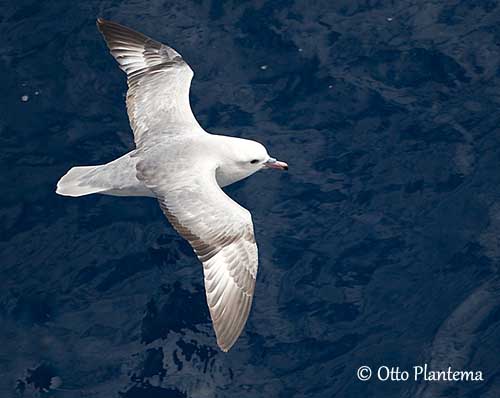
Fr: Fulmar argenté
Ang: Southern Fulmar - Antarctic Fulmar - Silver-grey Fulmar
All: Silbersturmvogel
Esp: Fulmar Austral
Ita: Fulmaro antartico
Nd: Grijze Stormvogel
Sd: Sydstormfågel
Photographers:
Tom Merigan
Tom Merigan’s Photo Galleries
Otto Plantema
Trips around the world
Text by Nicole Bouglouan
Sources:
HANDBOOK OF THE BIRDS OF THE WORLD vol 1 by Josep del Hoyo-Andrew Elliot-Jordi Sargatal - Lynx Edicions - ISBN: 8487334105
BirdLife International (BirdLife International)
New Zealand birds and birding (Narena Olliver)
Wikipedia, the free encyclopaedia
Australian Antarctic Division: Leading Australia's Antarctic Program
Southern Fulmar
Fulmarus glacialoides
Procellariiformes Order – Procellariidae Family
INTRODUCTION:
The Southern Fulmar is found in the Southern Hemisphere. It is included in the genus Fulmarus along with the Northern Fulmar. Other names can be used such as Antarctic Fulmar and Silver-grey Fulmar.
This is a gregarious species, often feeding, resting and travelling in large flocks. During summer, it is one of the commonest bird species of the circumpolar pack ice. Extreme weather and future climate change are the main threats for these birds.

DESCRIPTION OF THE BIRD:
Biometrics:
Length: 46-50 cm
Wingspan: 110-120 cm
Weight: 700-1000 g
The adult has gull-like appearance. The head is white. Neck and mantle are pale silver-grey, becoming darker grey on back and upperwings. The wing tips are black and show a rectangular white patch on the inner primaries. The trailing edge is blackish. Uppertail-coverts and rectrices are paler with indistinct white terminal band.
The underparts are mostly white. On the underwing, we can see a narrow dark trailing edge. There is sometimes a grey wash on breast sides.
The bill is pale pink with black tip and blue-grey tubular nostrils and base of upper mandible. The eyes are dark brown to blackish. Legs and webbed feet are pale pink with variable greyish areas.
Both adults are similar although the female is usually slightly smaller than male.
The juvenile resembles adults, with narrow paler fringes on mantle and inner upperwing-coverts. The bill is weaker.
RANGE:
The Southern Fulmar occurs in Southern Ocean. It breeds in Antarctica and on adjacent glaciated islands including Scotia Arc and N to Bouvet Island.
After breeding, it moves N away from the pack ice and reaches open water off coast of South Africa, Australia and New Zealand, and South America to Central Chile and South Brazil.
HABITAT:
The Southern Fulmar breeds on steep rocky slopes and cliffs, with the nests placed on ledges or in cavities. This species is also recorded well inland in Antarctica.
Outside the breeding season, it is at sea where it is highly nomadic, and usually moves N to open water.
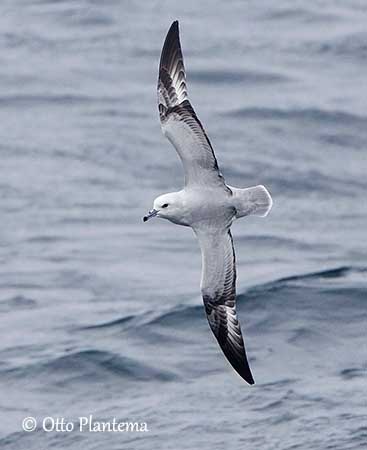
CALLS AND SONGS: SOUNDS BY XENO-CANTO
The Southern Fulmar is silent at sea, but while feeding in flocks and at the nest, it gives loud cackling or rattling calls. We can also hear a repeated “kew-kew-kew”. The chick produces “che-che” begging calls for food.
BEHAVIOUR IN THE WILD:
The Southern Fulmar feeds mainly on krill, fish and squid according to the range. It also takes carrion, small sick birds, offal and refuse from fishing vessels.
It feeds by surface-seizing or surface-skimming, and may perform shallow dives to catch a prey. It often feeds in flocks and sometimes with other seabird species. They are highly gregarious birds, but they become noisy and aggressive within the feeding flock.
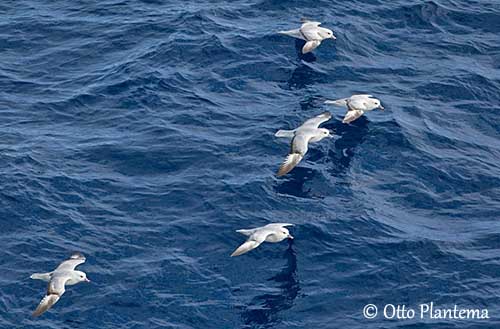
During the breeding season, they breed in colonies. Mates are monogamous with long-term pair-bonds. The nest-site is often reused in several following years.
They perform courtship displays during which both mates perch side-by-side while calling loudly. They wave their heads, touch their bills and perform mutual preening.
The Southern Fulmar is migratory and occurs widely in the Southern Ocean. Outside the breeding season, they move N away from the pack ice, and reach the open water off the southern parts of the large continents of South Africa, Australia and New Zealand, and South America on both W and E coasts.
The Southern Fulmar flies by flapping, gliding and soaring over the water on stiff wings. Fulmars may spend hours on the wing, flying at different heights over land or sea with a few wingbeats.
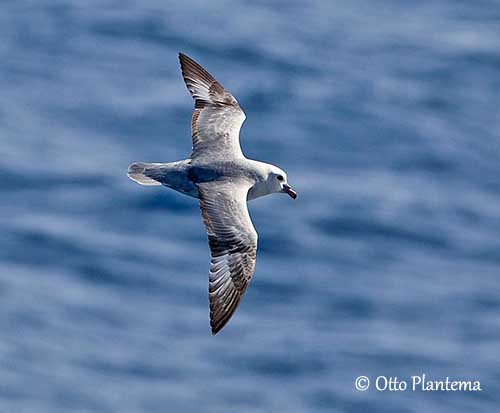
REPRODUCTION OF THIS SECIES:
The Southern Fulmar returns to the colonies in October and performs a short (4 days) pre-laying feeding trip. The breeding season starts in November and the laying occurs during the first two weeks of December.
They breed colonially on rocky ledges and in cavities on steep rocky slopes and cliffs. The nest is a scrape lined with gravel and placed on ledge or in cavity, protected from the wind.
The female lays a single white egg. The incubation lasts 46-47 days, shared by both adults. They take turns in stints of 3-9 days. At hatching, the chick has whitish-grey down, whiter on head and neck. It is brooded and guarded for the first 2-3 weeks of its life. It is fed on krill and fish by both parents. It fledges about 50-52 days after hatching, usually in March.
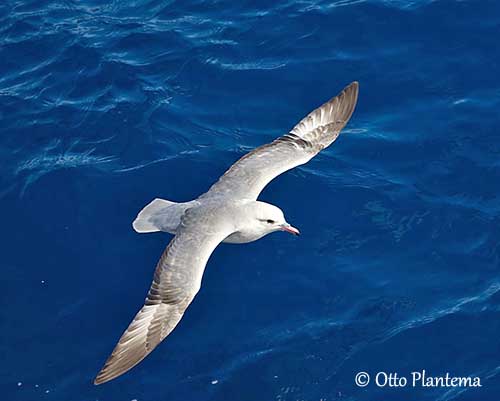
A weak chick can be harassed and killed by skuas. The adults defend the nest by threatening postures, lunging forwards with wide open bill. Both adults and chicks may sometimes squirt stomach oils at predators, birds or humans, when they are threatened.
PROTECTION / THREATS / STATUS:
The Southern Fulmar has large stable population estimated at about 4,000,000 individuals. This species has large range, but it can be affected by extreme weather and climate change, including the reduction of the sea-ice cover, involving the decrease of preys in some areas.
But currently, the Southern Fulmar is evaluated as Least Concern.